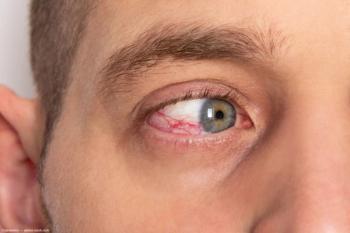
- July digital edition 2020
- Volume 12
- Issue 07
Safe & effective ocular triage in the COVID-19 era
How one OD made hard decisions during a time of emergent care.
Pre-COVID-19, most optometrists thought relatively little about ocular triage. Aside from an OD or staff worker fielding a phone call from a patient and deciding how urgently he needed to be seen, resources were typically greater than demand and there was little need to think deeply or systematically about principles of ocular triage.
Essentially, ODs’ doors were always opened, the welcome mat laid out, and the stakes relatively low.
However, COVID-19 turned the world, and eye care, upside down. With “routine” eye examinations suspended, ODs were forced to consider anew the practice of triage when a simple visit to the optometrist became a potentially lethal act for patients and the doctors and staff who care for them.
Although I am accustomed to triaging in my Department of Veterans Affairs practice where demand is often greater than resources, COVID-19 caught me flat-footed as well. Like everyone else, I scrambled to obtain personal protective equipment (PPE), institute new disinfection and screening protocols, and make plans for altered patient flow. What I have spent the most time doing is reviewing charts and deciding the “who, when, what, and how” of pandemic patient care.
I started the process with expectations of how I would proceed. In some cases, those expectations panned out; but the “new normal” also contained a few surprises.
This article is a summary of the lessons I have learned about ocular triage during the initial period of the COVID-19 epidemic and will cover four areas:
– Defining triage and how the process applies to eye care
– Discerning differences among “routine” eye care, ocular “urgencies,” and true ocular “emergencies”
– Applying triage principles to surveillance of established ocular disease patients
– Considering how COVID-19 impacts referrals to ophthalmology for secondary care and ocular surgery
Triage and how it applies to eye care
The word “triage” is derived from the French word trier, which means “to choose, pick out, or separate from others, to sort” and was originally used in agriculture.1 Today, triage is almost exclusively used in a healthcare context and a formal definition is: allocation of a medical resource occurring under conditions of scarcity performed by a healthcare worker using an established system or plan.2 A simpler working definition is: the process of sorting through the sick and injured and choosing those with the best chance of benefiting from immediate care.
Historians trace the origins of triage to several ancient battlefield narratives, but they commonly place the first formal model in the early 19th century and attribute it to French military surgeon Baron Dominique-Jean Larrey, chief surgeon of Napoleon’s Imperial Guard.2 Our conceptions of triage are shaped by culture and media, such as the popular TV shows “M*A*S*H*,” “China Beach,” and “ER” that depict triage under the stresses of acute battle injuries and the harried and demanding pace of the emergency department in an inner city public hospital. However, triage can apply to any specialty and setting, including inpatient or outpatient, in which demand is greater than available resources.
Triage carries a strong utilitarian connotation: to do the greatest good for the most and cause the least harm to the fewest.3 In the initial stages of the COVID-19 pandemic, public health officials decided the suspension of routine eye care and limiting face-to-face (F2F) care only to patients with ophthalmic urgencies and emergencies was necessary to “flatten the curve” of the pandemic to prevent overload of hospital critical care resources. Essentially, they considered slowing the spread of the coronavirus as the greatest good and the potential negative outcomes associated with delays in routine eye care as the least harm.
As of this writing, after an extended plateau in new cases and overall decline in the COVID-19 death rate for several weeks, the U.S. is experiencing a spike in new cases in 22 states located primarily in the Sun Belt and the West, as most state and local stay-at-home orders expire, businesses reopen, and public activities and gatherings increase. Public health officials point to pandemic “fatigue” and the desire to return to normal activities, recent street demonstrations and protests across the country, and poor compliance with wearing masks and social distancing as factors in this increase.4
Routine eye care is also resuming but at a reduced volume and rate to allow for social distancing and disinfection. The pandemic’s ebb and flow will likely continue to impact our practices for an extended period. Reduced access to eye care because of the “speed bumps” of disinfection and screening protocols and/or the “throttle” of fresh spikes in new cases and more stay-at-home advisories or orders are optometry’s and ophthalmology’s “new normal” for the foreseeable future.
Decreased access has a domino effect, and what happens at the primary-care level also influences secondary care. For instance, ODs may discover that ophthalmologists may not as readily accept referrals for secondary treatment and surgery because MDs are also experiencing more constriction to patient flow and dealing with a larger-than-normal backlog of pent-up care created by the initial shutdown.
Principles of triage should continue to guide ODs’ thinking during the pandemic as they attempt to balance the vision needs and ocular health of their patients with public health concerns. This continuous process will involve deciding whether to see patients F2F or virtually, how long visits should last, what procedures and tests should be done in-office, and how far apart (or if) to schedule follow-up exams.
‘Routine’ versus ‘urgent’ versus ‘emergent’
Using the word “routine” to describe a comprehensive eye exam can be misleading. From experience, ODs know that they frequently detect and diagnose sight-threatening disease and life-threatening systemic conditions during a so-called “routine” exam. Patients often hesitate to speak up about “minor” symptoms until asked, and targeted follow-up questions often lead to an unexpected but timely diagnosis.
Patients vary in their tolerance of eye symptoms and blurred vision, and one’s occupation and activities of daily living (ADLs) can affect their perception of the urgency of their vision problems. ODs differ as well in how they triage and classify patient complaints and decide who should receive expedited care.
In the pandemic’s early stages, numerous ophthalmic organizations offered triage guidelines about which ocular conditions had a high enough risk of vision loss to outweigh the risk of virus transmission and thereby warrant F2F visits.5-7 While most protocols were in general agreement, there were some differences in rankings and prioritization, and little distinction was made between ocular “urgencies” and “true emergencies.”
One way to distinguish between the two is to consider how quickly morbidity and/or mortality could occur without intervention. Based on that criterion, a true ocular emergency could be classified as a condition that results in irreversible blindness and/or death within hours in the absence of treatment.8
Endophthalmitis, intraocular foreign bodies, chemical injury, secondary glaucoma (for example, inflammatory, hyphema, etc.) with extremely high intraocular pressure (IOP), acute angle closure glaucoma (AACG), orbital cellulitis, and open globe trauma could all be correctly classified as true ocular emergencies. Possible additions to that list could include central retinal artery occlusion (CRAO) if diagnosed within hours of onset, extraocular muscle entrapment with muscle necrosis, and signs and symptoms of a cerebrovascular event such as sudden onset diplopia, cranial nerve palsies, and sudden vision or visual field loss.
The majority of acute conditions and symptoms that typically present to optometrists such as flashes and floaters, external ocular foreign bodies, retinal tears and detachments, uveitis, corneal ulcers, contact lens-associated red eye, acute conjunctivitis, vitreous hemorrhages, choroidal neovascular membranes (CNV), and even arteritic anterior ischemic optic neuropathy (AAION) may be more correctly classified as “urgencies” because they can usually be diagnosed and managed within a matter of days and not result in irreversible blindness and/or death.
Regardless of these distinctions, ODs should continue F2F exams or expedited referrals for patients who have the above conditions, even amid strict “stay at home” orders and quarantine, provided proper PPE is used, screening and sanitation protocols are followed, and the patient has not tested positive for COVID-19 and has no signs, symptoms, or multiple risk factors for the disease.
For patients who have tested positive for COVID-19, or who are persons under investigation (PUI), most guidelines recommend that ocular urgencies or emergencies be managed in a hospital setting more equipped to provide the highly specialized care and strict disinfection controls needed, or if the condition allows (for example, acute conjunctivitis), remotely via telemedicine.
Diagnosing and managing acute conjunctivitis during COVID-19 deserves special mention. Because of reports of the presence of the novel coronavirus in tear secretion and follicular conjunctivitis associated with COVID-19 cases,9,10 ODs should take special caution in dealing with “red eyes” in F2F visits.
Because the majority of cases of acute conjunctivitis are self-resolving, most recommendations have been to provide ocular telehealth care if possible and supportive therapy such as artificial tears, cool compresses, and oral non-steroidal anti-inflammatory drugs (NSAID) and/or acetaminophen to avoid the risk of a F2F visit. Contact lens wear may complicate matters and tip the scale toward an in-person office visit. Both optometrists and ophthalmologists have often used telemedicine by means of traditional phone calls and live televideoconferencing platforms to treat conjunctivitis during COVID-19.11
However, not all patients and their problems fit into neat categories and boxes. Clinical judgement and case-by-case evaluation are always paramount. While refractions weren’t regarded as “essential” during the acute phases of the pandemic, a -6.00 D delivery truck driver whose glasses break and does not have a backup pair or contact lenses can quickly jump in priority from “routine” to “urgent.”
Prioritizing surveillance of established patients with ocular disease
In addition to triaging acute conditions, ODs should prioritize follow-up care for established patients with existing ocular disease. Factors to consider are the practitioner’s knowledge of the individual patient, the natural course of the condition, previous treatment, existing vision impairment, and markers of progression.
While not all-encompassing, I found it useful to order my thinking around what I coined the “big four” causes of vision loss in my clinic: glaucoma, diabetic retinopathy (DR), age-related macular degeneration (AMD), and cataracts.
1 GLAUCOMA
When I started reviewing charts to prioritize care and reschedule patients, I assumed that because about 40 percent of my patient load consists of the diagnosis, treatment, and surveillance of primary open-angle glaucoma (POAG) patients and glaucoma suspects, these would comprise the bulk of my F2F follow-ups.
Counterintuitively, this turned out not to be the case.
Instead, I discovered the majority of my POAG patients were, inasmuch as I could discern, stable enough to defer a majority of their follow-up visits judging from functional measurements such as progression analysis data from serial visual fields and structural information gained from serial optic nerve assessments and retinal nerve fiber layer (RNFL) optical coherence tomography (OCT). Very few were progressing rapidly enough to warrant the risk of keeping an upcoming F2F follow-up visit during the early phases of the pandemic when cases were rising exponentially, and the majority were rescheduled for 2 to 4 months later.
During chart review, I found I was already comanaging with or had permanently transferred care to glaucoma specialists in most cases of advanced and poorly controlled cases of POAG and secondary glaucoma. I have a handful of very elderly patients with advanced or end-stage glaucoma and multiple systemic comorbidities who have already received maximum medical and surgical treatment and whose IOPs are as low as reasonably possible and can no longer preform reliable visual fields. For the most part, I deferred their F2F follow-ups and instead talked by phone with them or their caretakers and hoped for the best.
Lengthening the interval between follow-up visits these past few months is a continuation of a practice I adopted in recent years as I reconsidered the traditional, every 3 to 4 month glaucoma follow-up protocol and looked for patients with milder glaucoma and good compliance whom I could safely monitor with fewer in-office visits. I have the advantage in my practice of being able to monitor if patients are refilling their drops, an indirect—but not foolproof—measurement of compliance. Reviewing that information, refilling their drops, talking with patients by telephone to reinforce compliance and explain why we were deferring their care reduced F2F visits, and most likely, virus transmission.
New devices are now enabling home IOP measurement, and while these would enhance the quality of remote care, unfortunately they are not yet scalable and affordable enough to use on a widespread basis.12 While glaucoma tends to progress slowly, ODs must remember progression can vary widely and occur in a sudden and non-linear fashion, even in the presence of low IOP.13,14 As always, case-by-case clinical judgement is important, and the maxim “know thy patient” has never been truer than in the current moment.
2 DIABETIC RETINOPATHY
In contrast to glaucoma, I discovered the need to keep a tighter rein on my patients with DR and left in place more of their scheduled F2F follow-up visits for serial dilated fundus exams and macular OCTs. This was particularly true for patients with higher risk of progression, especially those patients with moderate and severe nonproliferative retinopathy (NPDR) accompanied by non-centered diabetic macular edema (DME) and good central vision whom I were closely monitoring or co-managing with retinal specialists.
I reasoned that during the pandemic, DR patients would likely see their primary-care providers (PCP) less often and might experience discontinuity in their systemic care and monitoring of their disease, be more prone to poor compliance with treatment and diet, perhaps from “stress eating” under conditions of isolation and quarantine, and also become less physically active.
Follow-up visits with these patients confirmed my suspicions as many of them have shown progression of their retinopathy and worsening of their DME. Retinal specialists generally performed only the most critical intravitreal injections (IVIs) in the early phase of the pandemic, and now many are scrambling to perform more such procedures to alleviate the pent-up demand that has developed.
When assessing diabetic retinopathy patients during the pandemic, ODs should triage using DR severity, evaluating the severity and location of DME, blood glucose control and HbA1c, and DR natural history.15 Monitoring less sight-threatening diabetic retinopathy via fundus photos and ultra-wide field imaging (UWF) is an evidence-based alternative to dilated fundus exams (DFE) when care is less accessible or when patients prefer to reduce F2F care to reduce their risk of viral transmission.16
3 AGE-RELATED MACULAR DEGENERATION
Like DR patients, delaying care and deferring routine F2F follow-ups of AMD patients during COVID-19 can contribute to poor visual outcomes. AMD can convert from dry to wet forms and progress rapidly. If possible, ODs should closely monitor with F2F exams those patients with high-risk characteristics such as “soft,” confluent drusen, calcified drusen, previous wet AMD with a history of treatment, and existing severe vision loss in one eye.17
One study showed optometrists and ophthalmologists in primary eyecare settings equally underdiagnose AMD, especially in subclinical and early stages, misjudge the stage of severity, and are often too passive in management and treatment.18 Additionally, one study demonstrated the importance of adherence to follow-up exams in patients with exudative AMD and documented worse visual outcomes associated with longer follow-up intervals.19
While home monitoring via Amsler grid and newer automated methods may be valuable,20 even patients who are engaged and vigilantly monitor their vision sometimes miss clinically significant changes marking progression in disease severity. There is no substitute for F2F visits with serial OCTs and DFEs for monitoring AMD progression, even in the COVID-19 era.21
Because IVIs are considered essential and still available even under stringent stay-at-home orders and isolation, ODs should monitor AMD patients with in-person visits assuming the visits can be conducted safely.22
4 CATARACTS
In most cases, cataract surgery was considered “nonessential” and suspended during the early stages of COVID-19. Although ophthalmic surgeons are performing this and other elective procedures again, patients with milder vision loss and less effect on their ADLs may receive less priority and experience delays in scheduling surgery.
During the pandemic, ODs should make an even greater effort to inform patients of the risks versus benefits of cataract surgery. For those patients who can reasonably wait, ODs can update prescriptions and use various coatings, tints, and other options to tide over patients until their cataracts can be removed.
Public health authorities and eyecare providers may have considered refraction to be “routine” in the initial stages of COVID-19. However, ODs performed some “urgent” refractions for patients whose cataracts were very symptomatic and who needed better vision to enjoy reading, watching TV, and perform other ADLs needed to better cope with increased stress associated with the pandemic and home isolation.
No guideline is a “one-size-fits-all” solution. ODs should always exercise professional judgement in deciding what actions are in the best interest of their patients and the public at large.
How COVID-19 affects referrals
Ophthalmology colleagues and consultants also face backlog and pent-up demand that may slow their ability to receive OD referrals. As they reopen and increase the inflow of patients into their offices, ODs should strive to better communicate and coordinate care with them by determining the priorities they use to schedule patients whose care was deferred. Sharing and discussing cases and images via telemedicine platforms and negotiating comanagement strategies could lead to better coordination of care, improved handoffs, better outcomes, and higher patient convenience and satisfaction.
Optometry as a profession has been trending toward a more “medical mindset” for many years, and the increased opportunities to monitor and manage chronic eye disease patients afforded by altered referral patterns in response to the pandemic may further accelerate this movement. Patients, ophthalmology colleagues, and the entire healthcare system are counting on ODs to stretch their comfort zones, step up their game to an even higher level, and do their part as essential members of the healthcare team to defeat the virus.
Conclusion
The significant morbidity and mortality generated by COVID-19 will continue for the foreseeable future. As patients return to OD offices, ODs will inevitably discover ocular and systemic morbidity resulting from deferred ophthalmic care and delays in treatment caused by the pandemic.
However, revisiting and practicing sound principles of ophthalmic triage can enable ODs to help minimize these losses and decrease the causality count in the war on COVID-19.
This generational challenge gives ODs an exclusive opportunity to carry forward the new techniques, technologies, and mindsets they have been forced to adopt out of necessity and use them to reshape eyecare delivery systems for maximum efficiency and safety in the post-pandemic “new normal.”
References:
1. Winslow GR. Triage and Justice. Berkeley, CA: University of California Press; 1982:169.
2. Iverson K, Moskop J. Triage in medicine: Part I: Concept, history, and types. Ann Emerg Med. 2007 Mar;49(3):275-281.
3. Moskop J, Iverson K. Triage in medicine: Part II: Underlying values and principles. Ann Emerg Med. 2007 Mar;49(3):282-287.
4. Bosman J, Smith M. Coronavirus cases spike across Sun Belt as economy lurches into motion. The New York Times. Available at: https://www.nytimes.com/2020/06/14/us/coronavirus-united-states.html. Accessed 6/15/20.
5. American Optometric Association. Doctors of optometry essential care guidelines for COVID-19 pandemic. Available at: https://www.aoa.org/coronavirus/health-policy-institute-covid-19/doctors-of-optometry-essential-care-guidelines-for-covid-19-pandemic. Accessed 6/10/20.
6. American Academy of Ophthalmology. List of urgent and emergent ophthalmic procedures. Available at: https://www.aao.org/headline/list-of-urgent-emergent-ophthalmic-procedures. Accessed 6/10/20.
7. The Royal College of Ophthalmologists. Management of ophthalmology services during the Covid pandemic. Available at: https://www.rcophth.ac.uk/wp-content/uploads/2020/03/RCOphth-Management-of-Ophthalmology-Services-during-the-Covid-pandemic- 280320.pdf. Accessed 6/10/20.
8. MacCumber MW, Ed. Management of Ocular Injuries and Emergencies, 4th Ed. Philadelphia, New York: Lippincott-Raven Publishers;1998:1.
9. Xia J, Tong J, Liu M, et al. Evaluation of coronavirus in tears and conjunctival secretions of patients with SARS-CoV-2 infection. J Med Virol. 2020 25 Feb. doi: 10.1002/jmv.25725.
10. Chen L, Meizhou L, Zhang Z, et al. Ocular manifestations of a hospitalised patient with confirmed 2019 coronavirus disease. Br J Ophthalmol. 7 April 2020;104:748-751.
11. Sim D, Thomas P, Canning C. Tackling COVID-19 with telemedicine. The Ophthalmologist. Available at https://theophthalmologist.com/subspecialties/tackling-covid-19-with-telemedicine. Accessed 6/10/20.
12. Freedman S. Monitoring IOP at home: A work in progress. Rev Ophthalmol. Available at: https://www.reviewofophthalmology.com/article/monitoring-iop-at-home-a-work-in-progress. Accessed 6/10/20.
13. Chun Wai Chan T, et al. Risk factors for rapid glaucoma disease progression. Am J Ophthalmol. 2017 Aug;180:151-157.
14. Saunders LJ, Medeiros FA, Weinreb RN, Zangwill LM. What rates of glaucoma progression are clinically significant? Exp Rev Ophthalmol. 2016;11(3):227-234.
15. Wong T, Sun J, et al. Guidelines on diabetic care: The International Council of Ophthalmology recommendations for screening, follow-up, referral, and treatment based on resource settings. Ophthalmology. 2018 Oct;125(10):1608-1622.
16. Date RC, Shen KL, Shah BM, et al. Accuracy of detection and grading of diabetic retinopathy and diabetic macular edema using teleretinal screening. Ophthalmol Retina. 2019 Apr;3(4):343-349.
17. Heesterbeek TJ, Lorés-Motta L, Hoyng CB, et al. Risk factors for age-related macular degeneration. Ophthalmic Physiol Opt 2020 Mar;40(2):140-150.
18. Neely DC, Bray KJ, Huisingh CE, et al. Prevalence of undiagnosed age-related macular degeneration in primary eye care. JAMA Ophthalmol. 2017 Jun 1;135(6):570-575.
19. Ramakrishnan MS, Yu Y, Vanderbeek BL. Association of visit adherence and visual acuity in patients with neovascular age-related macular degeneration: Secondary analysis of the comparison of age-related macular degeneration treatment trial. JAMA Ophthalmol. 2020 Feb 6;138(3):237-242.
20. Ward E, Wickens RA, O’Connell A, et al. Monitoring for neovascular age-related macular degeneration (AMD) reactivation at home: the MONARCH study. Eye (Lond). 2020 May 4. doi: 10.1038/s41433-020-0910-4.
21. Antaki F, Dirani A. Treating neovascular age-related macular degneration in the era of COVID-19. Graefes Arch Clin Exp Ophthalmol. 2020 Apr21;1-3. doi: 10.1007/s00417-020-04693-w.
22. Korobelnik J-F, Loewenstein A, Eldem B, et al. Guidance for anti-VEGF intravitreal injections during the COVID-19 pandemic. Graef’s Arch Clin Exp Ophthalmol. 2020 Jun;258(6):1149-1156.
Articles in this issue
over 4 years ago
How one OD encouraged glaucoma medication adherenceover 5 years ago
What to do if you're hit with tear gasover 5 years ago
July 2020: Best of Q&Aover 5 years ago
Light versus wellness: a modern dilemmaover 5 years ago
COVID-19 response brings new protocolsover 5 years ago
MITA Eyewear debuts stylesover 5 years ago
12 recommendations for prescribing opioidsover 5 years ago
3 steps to getting started with dry eye treatmentover 5 years ago
The dropless future: SLT as a first-line treatment for glaucomaNewsletter
Want more insights like this? Subscribe to Optometry Times and get clinical pearls and practice tips delivered straight to your inbox.



















































.png)


